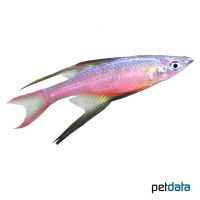Threadfin Rainbowfish (Iriatherina werneri)
| Threadfin Rainbowfish Iriatherina werneri | |
|---|---|
| Name | Threadfin Rainbowfish |
| Name Lat. | Iriatherina werneri |
| Family | Rainbowfishes |
| Family lat. | Melanotaeniidae |
| Order | Silversides |
| Order lat. | Atheriniformes |
| Origin | Australia, New Guinea |
| Habitat | Streams, ponds |
| Diet | Omnivore |
| pH | 6.0-7.0 |
| Behavior | Peaceful |
| Keeping | Swarm |
| Care Level | Moderate |
| Reproduction | Egg scatterer |
| Breeding | Moderately difficult |
| Life Span | 2-4 years |
| Protection | No |
| Metric Units | |
| Size | 4 cm |
| Temperature | 22-28 °C |
| Hardness | 1-12 °dH |
| Aquarium | 60 l |
| US Units | |
| Size | 1.6" |
| Temperature | 72-82 °F |
| Hardness | 18-214 ppm |
| Aquarium | 15 gal |
Distribution and habitat
Filigree rainbowfishes are found in northern Australia on the Cape York Peninsula and in southern New Guinea between the Merauke and Fly Rivers. There they live in the clear water of shallow streams, oxbow lakes and swamps with muddy bottoms and dense vegetation.
Maintenance
The aquarium should have dense background and border planting, with shelters and hiding places (roots) and plenty of swimming space. A dark substrate of sand or fine gravel covered with some foliage (e.g. sea almond leaves), partially shaded light (floating plants) and soft, slightly acidic water as well as a weak current is ideal.
No ammonia, ammonium and nitrite should be detectable in the water, and the nitrate value should not exceed 100 mg/l. To ensure the water quality and oxygen content, a filter and heater adapted to the aquarium size is required, as well as lighting for the species-appropriate day-night rhythm of the animals.
Diet
In nature they feed on zooplankton and small insects. The food supply consists of live, frozen and dry food for nano fish. For a balanced diet, feed them several times a day with a high-quality dry food (flakes, granules) as well as Artemia nauplii, Cyclops, Moina, Daphnia or mosquito larvae (live or frozen). In addition, they need regular vegetable food in the form of fine granulated or flake food with spirulina or kelp. Only feed as much as will be eaten within a few minutes. A regular and varied diet promotes good health.
Behaviour and compatibility
They are lively, swimming swarm fish and at least 5, but preferably much more should be kept together, whereby the number of females should predominate. In the shoal the males show their most beautiful coloration. These very peaceful fish can be socialized well with other calm and small fish (nano fish) as well as shrimps
Basically, only compatible fish species with similar demands on water conditions and water temperature should be socialized.
Sex dimorphism
The male is larger, more colorful and has a much longer extended anal and second dorsal fin.
Reproduction and breeding
They are free spawners, which during the reproductive period daily in the morning (morning sun) deposit their eggs with adhesive filaments on fine-leaved plants. The fry hatch after 8-12 days. The parents are spawn predators.
Fry must be fed several times a day with special rearing food (dust food, Artemia nauplii, infusoria). In community tanks breeding is hardly possible, because the spawn is easy prey.
Important
They like to jump, so the aquarium should be well covered
The fish have a small mouth and a very narrow gullet, and accordingly can accept only the smallest, floating food.
The foliage (sea almond tree, oak, etc.) enriches the water with humic substances, naturally lowers the pH value and, when rotting, promotes the development of microorganisms, which are a valuable secondary food source. Alder cones are also well suited for this purpose.
The well-being of the fish should be monitored regularly. The temperature should be checked daily, the pH, hardness and nitrate value at least every 14 days. Regular partial water changes are recommended, even if the contaminant level has not yet reached the upper limit. Sudden changes in water quality should be avoided. Newly introduced fish must be accustomed slowly to the water in the aquarium.
Further literature can be found in your pet store.
References
Text: Werner Winter; Image: petdata
Source: BMELV (1998): Tierschutzgutachten - Haltung von Zierfischen (Süßwasser); BAENSCH & RIEHL (2004): Aquarien Atlas Bd. 2, Mergus Verlag; ENGELMANN (2005): Zootierhaltung - Tiere in menschlicher Obhut: Fische, Verlag Harri Deutsch
- Gemäß § 21 Abs. 5 Tierschutzgesetz idgF
